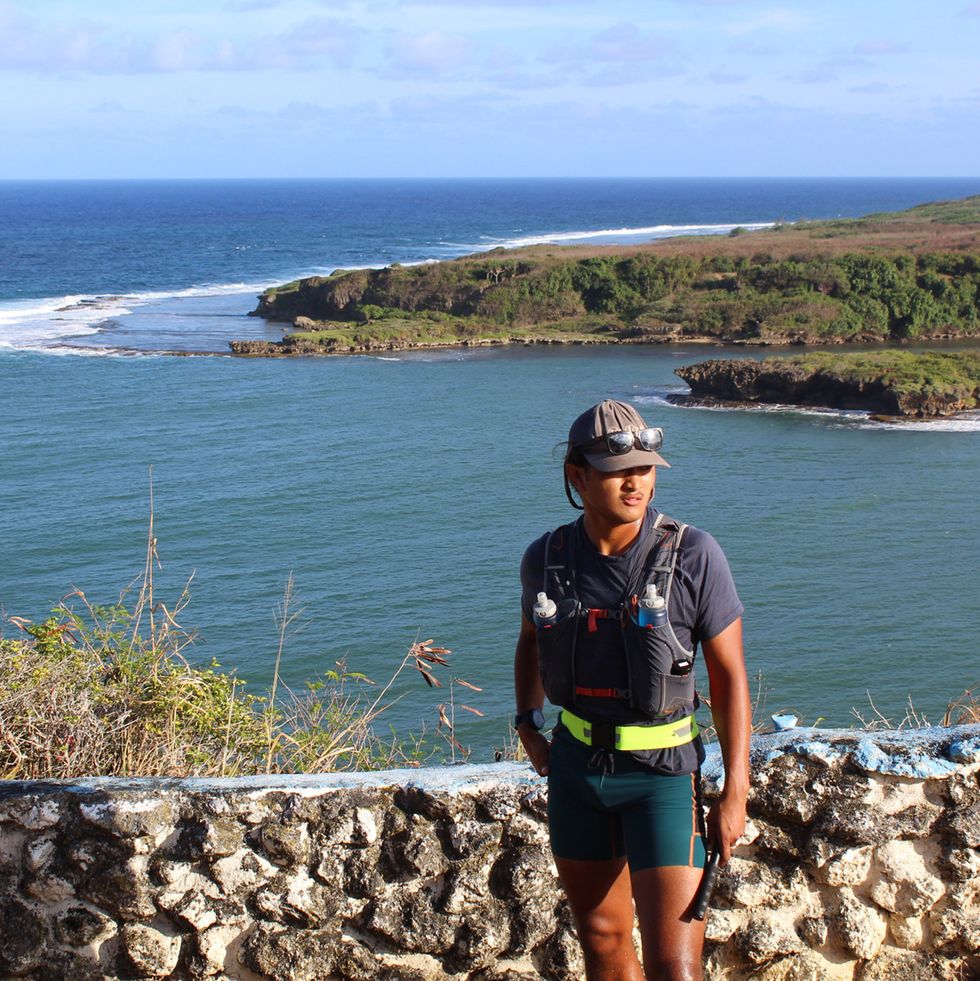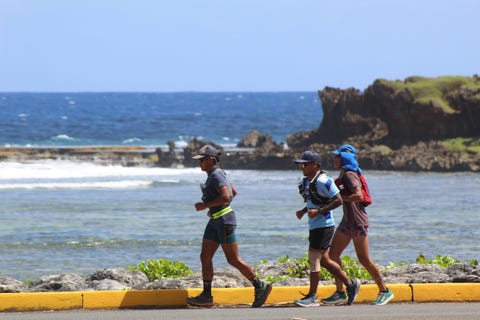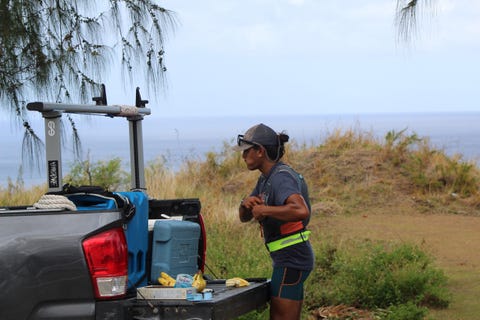
He completed a 100-mile fastest known time around Guam and the first-ever century-distance route in the Mariana Islands.
Runner’s World | June 2022
Read the full story at runnersworld.com and here:
By the time ultrarunner Dillon Quitugua finished running 100 miles back in March in a figure-eight route around the periphery of Guam, the 25-year-old was physically exhausted—and grinning ear to ear. He’d established a new Fastest Known Time (FKT), coined the Gerald Quitugua’s Mariana’s 100. After more than 32 hours on his feet, Quitugua had faced torrential downpours, brutal heat, heavy humidity, and steep hills on the tropical island’s southern half totaling 5,243 feet of elevation.
The athlete’s motivation for the century run had been met: to help empower marginalized Pacific Islanders to pursue their endurance goals, dreams—especially ambitions that are stigmatized—and to be the best version of themselves.
“I want to change the motif that Hawaiians and Pacific Islanders don’t do certain things outside of the traditional paradigm,” Quituguag told Runner’s World.

From left, Dillon Quitugua, Brandon Perez and Johnny Barsano during the Mariana’s 100.
Ultimately, trail and ultrarunning helps him feel whole. “Running is the only time in my life where I can feel two things: empowered in myself and close—and I don’t mean this religiously—to God. I feel like I’m doing something that is a part of my soul and I live very closely to the universe when I run,” he said.
What It’s Like to Set the Guam FKT: Gerald Quitugua’s Mariana’s 100
Situated at the northern periphery of Micronesia, Guam is the southernmost island in the Mariana archipelago. Shaped like a crescent, the Marianas Island chain is the origin of the Chamorro people and Quitugua’s ancestors. O’ahu, Hawaii, where Quitugua and his immediate family live today, sits 3,770 miles to the east.
As his feet pounded grass and sand, Quitugua ran along the edge of a paved road to complete his FKT. “With the heat and humidity, it’s like you’re running in a sauna uphill. The first 50 miles were brutal and took us 18 hours,” described Quitugua, who named the FKT after his late father. He started the race with Johnny Keoni Barsano and Brandon Perez, who both transitioned to be support crew before the finish.
The route is an expansion of an iconic annual local race, the GRC Perimeter Relay, which includes a 50-mile ultramarathon solo distance and a 48.6-mile relay distance for teams. The GRC Perimeter Relay was the southern loop of Quitugua’s course, then he added the northern loop. “With 5Ks commonly taking place every weekend, running is a big part of Guam but ultrarunning isn’t,” said Quitugua, who received a rush of positive feedback from the local community when he ran, including athletes that joined him and an appearance from Guam Governor Lou Leon Guerrero upon the finish.
“It’s such a powerful thing for people who are from my culture to see someone else from their culture ultrarunning and trail running—it becomes more relatable and possible in their minds,” said Quitugua.
When times get tough during those ultra long runs, Quitugua turns to his reason for running in the first place, and encourages those who are interested in the feat to the do the same. “I would tell someone who is curious, running an ultra just comes with discipline. And knowing your why and having a strong sense of yourself and a purpose will allow you to do it. Your purpose may look different [from someone else’s],” he said. “Find whatever it is that gives you passion and after that passion, find the discipline.”
Quitugua’s purpose and passion? He wants to pave a path for Pacific Islanders to embrace ultrarunning.
“My ultramarathon passion pushes myself outside the paradigm of what being a Pacific Islander is. I wanted to bring that home to Guam, to do something that hasn’t been done there, open the mind of my people, inspire the younger generations of Guam and the Pacific Islands and lay testimony that we can do things that people in white spaces do,” said Quitugua.
To keep his goals going, Quitugua plans to launch and be the race director for an official annual 100-mile race on Guam that follows the Gerald Quitugua’s Mariana’s 100 route.
How Quitugua Got Started With Ultrarunning
A collegiate wrestler, Quitugua was first exposed to the practice of trail and ultrarunning while attending Western Colorado University in Colorado, where many mountain runners train and compete. Born and raised on O’ahu, Hawaii, Quitugua had never left the island before moving to the Centennial State.
“O’ahu’s perimeter is 135 miles around, and that island was my whole life for 18 years. I gained a huge curiosity about the world. Growing up in a lower middle-class family, I wanted to travel and experience new things the way I saw on Instagram,” Quitugua said.

Dillon Quitugua gets some fuel during the Mariana’s 100.JADEN GUERRERO / COURTESY JANJI
After studying abroad in Europe and Thailand, Quitugua became the first person in his family to graduate from college, in 2018. He then joined the Peace Corps and moved to Nepal, where he dove into mountain running. When the pandemic hit, he moved back to O’ahu, where he got a job as a delivery truck driver. He ramped up his running mileage, which was offset with 10-hour shifts on the road.
Befriending another local endurance athlete, Joseph Koyle, he and Quitugua designed and ran a 52-mile FKT route from the south to the north shore in O’ahu, as well as a 100 miler following the isle’s circumference. While training to race the 2021 Moab 240, a 240-mile continuous footrace in Utah, Koyle passed away in a motorcycle accident.
“I still ran the Moab 240, and do a lot of running for him now,” said Quitugua, who trained for the double-century race by running in the Everest region of Nepal, where he is currently based for a training month.
Running for The Tribe Collective and Pacific Islanders
In step with Quitugua’s personal inspiration, he ran the Gerald Quitugua’s Mariana’s 100 to promote the Tribe Collective, an organization cofounded by Quitugua, along with Perez, Koyle, and videographer Magdalena Steele.
The mission of the Tribe Collective is to empower individuals to be their best selves through unity and service, and to uplift Pacific Islanders.
To that end, the organization is launching a full scholarship for a Pacific Islander to travel and trek to Everest Base Camp, at the foot of Khumbu Glacier, in 2023. They will also debut a four-year scholarship to support a high school athlete for their gear and travel and an annual college scholarship of $5,000 per year.
Next, Quitugua aims to run the 2022 Tahoe 200 race and to establish O’ahu’s first 200-mile distance. He also aims to be among the first Pacific Islanders and the first-ever Chamorro man to summit the earth’s highest peak: 29,032-foot Mount Everest.
The Gerald Quitugua’s Mariana’s 100 race, once launched, will help to promote fundraising efforts for the Tribe Collective mission. You can support the mission by making donations via the Tribe Collective website.
